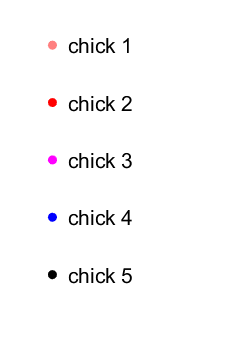Predictions & Data for this entry
| Model: std | climate: Cfb | migrate: | phylum: |
| COMPLETE = 2.5 | ecozone: TA | food: biCii | class: |
| MRE = 0.027 | habitat: 0iTg, 0iTh | gender: Dg | order: |
| SMSE = 0.003 | embryo: Tnsm | reprod: O | family: |
Zero-variate data
| Data | Observed | Predicted | (RE) | Unit | Description | Reference |
|---|---|---|---|---|---|---|
| ab | 23 | 23.24 | (0.01037) | d | age at birth | avibase |
| tx | 33 | 32.88 | (0.003636) | d | time since birth at fledging | Paul2000 |
| tp | 99 | 104.1 | (0.0518) | d | time since birth at puberty | guess |
| tR | 365 | 365 | ( 0) | d | time since birth at 1st brood | guess |
| am | 4380 | 4377 | (0.0007773) | d | life span | guess |
| Ww0 | 10 | 14.42 | (0.4419) | g | intitial wet weight | avibase |
| Wwb | 9.1 | 9.158 | (0.00642) | g | wet weight at birth | Paul2000 |
| Wwi | 72.4 | 71.6 | (0.01104) | g | ultimate wet weight | avibase |
| Wwim | 54 | 53.96 | (0.0008209) | g | ultimate wet weight for males | avibase |
| Ri | 0.01096 | 0.01119 | (0.02087) | #/d | maximum reprod rate | avibase |
Uni- and bivariate data
| Data | Figure | Independent variable | Dependent variable | (RE) | Reference |
|---|---|---|---|---|---|
| tW |   | time since birth | wet weight | (0.09605) | Paul2000 |
Pseudo-data at Tref = 20°C
| Data | Generalised animal | Pedionomus torquatus | Unit | Description |
|---|---|---|---|---|
| v | 0.02 | 0.03699 | cm/d | energy conductance |
| p_M | 18 | 320.7 | J/d.cm^3 | vol-spec som maint |
| k_J | 0.002 | 0.01317 | 1/d | maturity maint rate coefficient |
| k | 0.3 | 0.3007 | - | maintenance ratio |
| kap | 0.8 | 0.7094 | - | allocation fraction to soma |
| kap_G | 0.8 | 0.8 | - | growth efficiency |
| kap_R | 0.95 | 0.95 | - | reproduction efficiency |
Discussion
- Males are assumed to differ from females by {p_Am} only
- mod_1: Pseudo-data point k is used, rather than k_J; Data set tp and parameter t_R are added, the latter replacing clutch interval t_N. Postnatal T is based on PrinPres1991, see get_T_Aves. See further the revision page, theme puberty
Bibliography